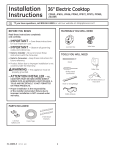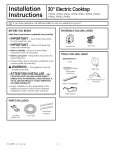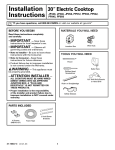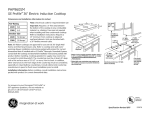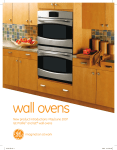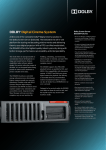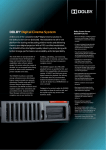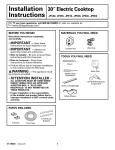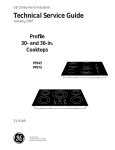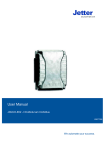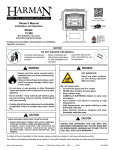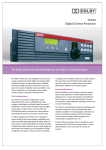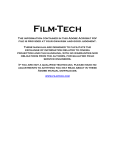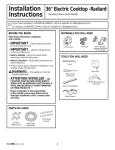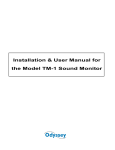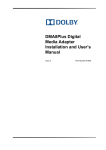Download Installation Instructions
Transcript
Installation 36" Electric Cooktop Instructions CP650, JP655, PP962, PP972, PP975, PP980, ZEU36K “If you have questions, call 800.GE.CARES or visit our website at: ge.com” Before You Begin MATERIALS YOU WILL NEED Read these instructions completely and carefully. IMPORTANT • — Save these instructions for local inspector’s use. IMPORTANT TOOLS YOU WILL NEED Pencil WARNING — This appliance must be Saber Saw Phillips Head Screwdriver properly grounded. ATTENTION INSTALLER — ALL • COOKTOPS MUST BE HARD WIRED (DIRECT WIRED) INTO AN APPROVED JUNCTION BOX. A “PLUG AND RECEPTACLE” IS NOT PERMITTED ON THESE PRODUCTS. • Proper installation is the responsibility of the installer and product failure due to improper installation is NOT covered under warranty. Ruler or Straightedge Safety Glasses PARTS INCLUDED 4 Screws (WB1X1137) 31-10636-2 (11-10 GE) Wire Nuts Junction Box • — Observe all governing codes and ordinances. • Note to Installer – Be sure to leave these instructions with the Consumer. • Note to Consumer – Keep these instructions for future reference. • Product failure due to improper installation is not covered under the Warranty. 2 Hold Down Brackets Foam Tape 1 1/8≤ Drill Bit & Electric or Hand Drill Installation Instructions IMPORTANT SAFETY INSTRUCTIONS For Your Safety Electrical Requirements •For Personal Safety, remove house fuse or open circuit breaker before beginning installation. Failure to do so could result in serious injury or death. •Be sure your cooktop is installed properly by a qualified installer or service technician. •To eliminate the risk of burns or fire due to reaching over heated surface elements, cabinet storage located above the surface units should be avoided. If cabinet storage space is to be provided, the risk can be reduced by installing a range hood that projects horizontally a minimum of 5" beyond the bottom of the cabinets. Cabinet installation above the cooktop may be no deeper than 13". •Make sure the cabinets and wall coverings around the cooktop can withstand the temperatures (up to 200°F) generated by the cooktop. •The cooktop should be easy to reach and lighted with natural light during the day. •Always disconnect the electrical service to the cooktop before repairing or servicing the cooktop. This can be done by disconnecting the fuse or circuit breaker. Failure to do this could result in a dangerous or fatal shock. Know where your main disconnect switch is located. If you do not know, have your electrician show you. This appliance must be supplied with the proper voltage and frequency, and connected to an individual, properly grounded branch circuit, protected by a circuit breaker or a time delay fuse as noted on name plate. We recommend you have the electrical wiring and hookup of your cooktop connected by a qualified electrician. After installation, have the electrician show you where your main cooktop disconnect is located. Wiring must conform to National Electrical Code. You can get a copy of the National Electrical Code, ANSI/NFPA No. 70-Latest Edition, by writing: National Fire Protection Association Batterymarch Park Quincy, MA 02269 The cooktop conduit wiring is approved for copper wire connection only, and if you have aluminum house wiring, you must use special UL approved connectors for joining copper to aluminum. You must use a two-wire, three conductor 208/240 VAC, 60 Hertz electrical system. A white (neutral) wire is not needed for this unit. The cooktop must be installed in a circuit that does not exceed 125 VAC nominal to ground. Refer to the name plate on your cooktop for the KW rating for your cooktop. Name plate location 2 Installation Instructions Pre-Installation Checklist WARNING – The electrical power to C Remove Installation Instructions from literature pack and read them carefully before you begin. the cooktop supply line must be shut off while connections are being made. Failure to do so could result in serious injury or death. A When preparing cooktop opening, make sure the inside of the cabinet and the cooktop do not interfere with each other. (See section on preparing the opening.) Be sure to place all literature, Owner’s Manual, Installations, etc. in a safe place for future reference. B Remove packaging materials and literature package from the cooktop before beginning installation. Literature Package Styrofoam Packaging HOT D Make sure you have all the tools and materials you need before starting the installation of the cooktop. E Your home must provide the adequate electrical service needed to safely and properly use your cooktop. (Refer to section on electrical requirements.) ON F When installing your cooktop in your home, make sure all local codes and ordinances are followed exactly as stated. Cooktop G Make sure the wall coverings, countertop and cabinets around the cooktop can withstand heat (up to 200°F) generated by the cooktop. 3 Installation Instructions Preparing the Opening 1 4 Cutout dimensions of the countertop The following MINIMUM clearance dimensions must be maintained. 13" MAX. Depth of uprotected overhead cabinets 2" MIN. Clearance from cutout to side wall on the right of the unit To insure accuracy, it is best to make a template when cutting the opening in the counter. 19-1/8" width of cut 30" MIN. Clearance from countertop to unprotected overhead surface 15" MIN. Height from countertop to nearest cabinet on either side of unit 1-3/4" Min. Between cutout and the wall behind the cooktop 2-1/2" Min. from front edge of cutout and front edge of countertop 2" MIN. Clearance from cutout to side wall on the left of the unit If a 30" clearance between the cooking surface and overhead combustible materials or metal cabinets cannot be maintained, a minimum clearance of 24" is required and the underside of the cabinets above the cooktop must be protected with not less than 1/4" insulating millboard covered with sheet metal not less than 0.0122" thick. 5 20-7/8" (21" SS) Depth on Monogram ZEU36K is 21-1/4' @ center. Cooktop 18-7/8" 3 33-3/4" Five inches (5") minimum vertical clearance between the cooktop bottom and any combustible surfaces. Make sure the wall coverings, countertop and cabinets around the cooktop can withstand heat (up to 200°F) generated by cooktop. Wall covering, cabinets and countertop must withstand heat up to 200°F. 2 Overall cooktop dimensions 36" (36-1/8" SS) 33-7/8" length of cut 3-1/4" Front 4-5/8" Rear at the conduit location 6-1/4" Rear on Model PP975 & PP980 5" Min. Vertical Clearance 4 Installation Instructions Installing the Cooktop 1 Installing the Junction Box 3 Attach Foam TAPE Install an approved junction box where it will be easily reached through the front of the cabinet where the cooktop will be located. The cooktop conduit is 4 feet long. Apply the foam tape around the outer edge of the glass. Do not overlap the foam tape. Bottom of Cooktop Foam Tape 16" Min. Cooktop Glass Note: On CP650S, PP962S, PP972S, PP975S & PP980S models, apply the foam tape around the outer edge of the glass on the sides and rear of the unit only. Install junction box so that it can be reached through the front of the cabinet. 4 Locate Mounting Parts Remove the Hold Down Brackets and screws from the literature package. IMPORTANT: The junction box must be located where it will allow considerable slack in the conduit for serviceability. Mounting Screw 5 Attach Brackets to Cooktop Screw the Hold Down Bracket to the side of the cooktop unit. Repeat for opposite side of cooktop. 2 Protect Surface of Cooktop Place a towel or tablecloth onto the countertop. Lay the cooktop upside down onto the protected surface. Bottom of cooktop Bottom of Cooktop Pre-Drilled Hole Foam Tape Cooktop Glass Cloth under Cooktop 5 Hold Down Bracket Installation Instructions Installing the Cooktop (CONT.) 6 Insert Cooktop Into Cutout 7 Attach Hold Down Brackets to Cabinet Insert the cooktop centered into the cutout opening. Make sure the front edge of the countertop is parallel to the cooktop. Make final check that all required clearances are met. Open the cabinet door and screw the Hold Down Brackets to the cabinet sides with the screws provided. Mounting Screw Burner Box Sides Cooktop Hold Down Bracket Use suitable fasteners for anchorage in cabinet sides Cabinet Side 6 Installation Instructions Installation—Electrical Connections A When making the wire connections, use the entire length of conduit provided. The conduit must not be shortened. E Once the connections are made, secure wires together using wire nuts. Red B With the cooktop in place, open the front of the cabinet door. Strain Relief Clamp C Insert the wires from the conduit through the opening of the junction box. Ground Red GROUNDING INSTRUCTIONS: Strain Relief Clamp The bare ground wire in the conduit is connected to the cooktop frame. Effective January 1, 1996, the National Electrical Code will not permit grounding through neutral. If used in new construction after January 1, 1996 or in a mobile home, recreational vehicle or if local codes do not permit grounding through the neutral white lead, attach the appliance grounding lead (green or copper) to the residence grounding conductor (green or bare copper) in accordance with local codes. When connecting to a 3 conductor branch circuit, if local codes permit, connect the bare ground connector lead of the cooktop to the branch circuit neutral (gray or white in color). Ground Black D Connect the red and black leads from the cooktop conduit to the corresponding leads in the junction box. Red Ground wire location Black Black IMPORTANT: If the cooktop is being installed into a blind counter (one with no cabinet opening below), wire connections must be made before putting the cooktop into the cutout opening. 7 Installation Instructions Checklists 1 Pre-Test Checklist 2 Operation Checklist A Remove all protective film, if present, and any stickers. A Remove all items from the top of the cooktop surface. B Check to be sure that all wiring is secure and not pinched or in contact with moving parts. B Turn on the power to the cooktop. (Refer to your Owner’s Manual.) Verify that all surface burners operate properly. C Check level of appliance. D Check that the cooktop is properly grounded. C Check that the circuit breaker is not tripped nor the house fuse blown. D Check that conduit is securely connected to the junction box. E See Owner’s Manual for troubleshooting list. NOTE TO ELECTRICIAN: The power leads supplied with this appliance are UL recognized for connections to larger gauge household wiring. The insulation of these leads is rated at temperatures much higher than the temperature rating of household wiring. The current carrying capacity of a conductor is governed by the wire gauge and also the temperature rating of the insulation around the wire. NOTE: ALUMINUM WIRING • WARNING: IMPROPER CONNECTION OF ALUMINUM HOUSE WIRING TO THE COPPER LEADS CAN RESULT IN A SERIOUS PROBLEM. • Splice copper wires to aluminum wiring using special connectors designed and UL approved for joining copper to aluminum and follow the manufacturer’s recommended connector procedure closely. NOTE: Wire used, location and enclosure of splices, etc., must conform to good wiring practice and local codes. 8 Instrucciones Estufa eléctrica de 36" de instalación CP650, JP655, PP962, PP972, PP975, PP980, ZEU36K “Si tiene alguna pregunta, llame al 800.GE.CARES o visite nuestro sitio Web en: ge.com” ANTES DE COMENZAR NECESITARÁ LOS SIGUIENTES MATERIALES Lea estas instrucciones por completo y con cuidado. IMPORTANTE • — Conserve estas instrucciones para el uso del inspector local. IMPORTANTE • — Cumpla con todos los códigos y reglas aplicables. • Nota para el instalador – Asegúrese de dejar estas instrucciones en poder del consumidor. •Nota para el consumidor – Conserve estas instrucciones para referencias futuras. • El mal funcionamiento del producto debido a una instalación incorrecta no está cubierto por la Garantía. Caja de empalmes Tuercas para cables NECESITARÁ LAS SIGUIENTES HERRAMIENTAS Lápiz ADVERTENCIA — Este aparato debe descargarse a tierra correctamente. Sierra Destornillador Phillips ATENCIÓN INSTALADOR — • TODAS LAS ESTUFAS DEBEN CONTAR CON CABLEADO (CABLEADO DIRECTO) A UNA CAJA DE EMPALMES APROBADA. ESTOS PRODUCTOS NO ACEPTAN ENCHUFES Y RECEPTÁCULOS. • La instalación correcta es responsabilidad del instalador, y el mal funcionamiento del producto debido a una instalación inadecuada NO está cubierto bajo la garantía. Regla o regla para nivelar Gafas de seguridad PARTES INCLUIDAS 4 Tornillos (WB1X1137) 2 abrazaderas de montaje Cinta de espuma 31-10636-2 (11-10 GE) 1 Broca perforadora de 1/8≤ y taladro eléctrico o manual Instrucciones de instalación INSTRUCCIONES DE SEGURIDAD IMPORTANTES PARA SU SEGURIDAD REQUISITOS ELÉCTRICOS •Para su seguridad personal, retire los fusibles de su hogar o bien abra el cortacircuitos antes de comenzar con la instalación. El no hacerlo puede resultar en lesiones serias o incluso la muerte. •Asegúrese que su estufa sea instalada correctamente por un instalador o técnico de servicio calificado. •Para eliminar el riesgo de quemaduras o incendio debido al contacto con los elementos de superficie calentados, debe evitarse el almacenaje en los gabinetes ubicados sobre los elementos de superficie. Si se cuenta con espacio en un gabinete, puede reducir el riesgo instalando una campana que se proyecte horizontalmente un mínimo de 5" más del fondo de los gabinetes. La instalación de gabinetes sobre la estufa no debe exceder 13" de profundidad. •Asegúrese que los gabinetes y las cubiertas de las paredes alrededor de la estufa puedan soportar las temperaturas generadas por la estufa (hasta 200 °F). •La estufa debe ser fácil de alcanzar y deberá contar con iluminación natural durante el día. •Siempre desconecte la toma eléctrica que va hacia la estufa antes de reparar o dar servicio a la estufa. Esto puede hacerse desconectando el fusible o cortacircuitos. No hacer esto puede resultar en un shock eléctrico peligroso o fatal. Sepa en dónde se localiza el interruptor principal de desconexión. Si no lo sabe, pídale a su electricista que le muestre la ubicación. Este aparato debe contar con el voltaje y frecuencia adecuados, y deberá conectarse a un circuito derivado individual debidamente descargado a tierra, protegido por un cortacircuitos o un fusible temporizado como lo indica la placa. Le recomendamos que un electricista calificado conecte el cableado eléctrico y conexión de su estufa. Después de la instalación, pídale al electricista que le muestre en dónde se localiza el interruptor principal de desconexión de su estufa. El cableado debe cumplir con el Código Nacional sobre Electricidad. Puede obtener una copia del Código Nacional sobre Electricidad, ANSI/NFPA No. 70-Última edición, escribiendo a: Asociación Nacional para la Prevención de Incendios Batterymarch Park Quincy, MA 02269 El cableado conductor de la estufa está aprobado para conexiones únicamente con cables de cobre, y si cuenta con cableado de aluminio, debe usar conectores especiales aprobados por UL para unir cobre con aluminio. Debe usar un sistema eléctrico con conductor de dos cables y tres conductores 208/240 VCA, de 60 Hertz. No se requiere un cable blanco (neutral) para esta unidad. La estufa debe instalarse en un circuito que no exceda 125 VCA nominales de descarga a tierra. Consulte el rótulo sobre su estufa para conocer la clasificación en kilovatios de su estufa. Ubicación del rótulo 2 Instrucciones de instalación LISTA DE VERIFICACIÓN PREVIA A LA INSTALACIÓN ADVERTENCIA – La corriente C Saque las instrucciones de instalación del paquete de material impreso y léalas cuidadosamente antes de comenzar. eléctrica a la tubería de abastecimiento de la estufa debe cortarse durante la realización de conexiones. El no hacerlo puede resultar en una lesión seria o la muerte. A Cuando se prepare para la abertura de la estufa, asegúrese que el interior del gabinete y la estufa no interfieran uno con el otro. (Consulte la sección de preparación de la abertura). Asegúrese de colocar todo el material impreso, Manual de propietario, Instalaciones, etc., en un lugar seguro para referencia futura. B Retire los materiales de empaque y el material impreso de la estufa antes de comenzar la instalación. Paquete de material impreso Empaque de espuma de poliestireno HOT D Asegúrese de contar con todas las herramientas y materiales que necesita antes de comenzar la instalación de la estufa. E Su hogar debe contar con el servicio eléctrico adecuado para el uso seguro y correcto de su estufa. (Consulte la sección de requisitos eléctricos). ON F Cuando instale la estufa en su hogar, asegúrese de cumplir todos los códigos y reglas locales tal y como se establecen. Estufa G Asegúrese de que las cubiertas de las paredes, el mostrador y los gabinetes alrededor de la estufa puedan soportar las temperaturas generadas por la estufa (hasta 200 °F). 3 Instrucciones de instalación PreparACIÓN DE LA ABERTURA 1 4 DIMENSIONES DEL ÁREA CORTADA EN EL MOSTRADOR Deben seguirse las siguientes dimensiones MÍNIMAS de espacio libre. 13" MÁX. Profundidad de los gabinetes superiores sin protección 2" MÍN. Espacio desde el área cortada hasta la pared lateral a la derecha de la unidad 30" MÍN. Espacio desde el mostrador hasta la superficie superior sin protección Para garantizar la precisión, es mejor crear una plantilla al momento de cortar la abertura en el mostrador. 19-1/8" ancho del corte 15" MÍN. Altura desde el mostrador hasta el gabinete más cercano a cualquiera de los lados de la unidad 2" MÍN. Espacio desde el área cortada hasta la pared lateral a la izquierda de la unidad 1-3/4" Mín. Entre el área cortada y la pared detrás de la estufa 2-1/2" MÍn. del borde frontal del área cortada y el borde frontal del mostrador Si no puede mantenerse un espacio de 30" entre la superficie de cocción y los materiales superiores inflamables o gabinetes metálicos, se requiere un espacio mínimo de 24", así como que el lado inferior de los gabinetes encima de la estufa estén protegidos con no menos de 1/4" de cartón gris aislante cubierto con láminas metálicas de no menos de 0.0122" de grosor. 5 20-7/8" (21" AO [acero inoxidable]) La profundidad en Monogram ZEU36K es de 21-1/4" en el centro. Estufa 18-7/8" 3 33-3/4" Espacio vertical mínimo de cinco pulgadas (5”) entre la parte inferior de la estufa y cualquier tipo de superficie inflamable. Asegúrese que las cubiertas de las paredes, el mostrador y los gabinetes alrededor de la estufa puedan soportar las temperaturas generadas por la estufa (hasta 200 °F). La cubierta de la pared, los gabinetes y el mostrador deben soportar calor hasta 200 °F. 2 DIMENSIONES GENERALES DE LA ESTUFA 36" (36-1/8≤ AO) 33-7/8" longitud del corte 3-1/4" Frente 4-5/8" Parte posterior en la ubicación del conducto 6-1/4" Parte posterior en los modelos PP975 y PP980 5" Mín. de espacio vertical 4 Instrucciones de instalación InstaLACIÓN DE LA ESTUFA 1 InstalACIÓN DE LA CAJA DE EMPALMES 3 APLIQUE LA CINTA DE ESPUMA Aplique la cinta de espuma alrededor del borde externo del vidrio. No aplique un exceso de cinta de espuma. Instale una caja de empalmes aprobada en un lugar de fácil acceso a través del frente del gabinete en donde pueda colocarse la estufa. El conducto de la estufa tiene 4 pies de longitud. Parte inferior de la estufa Cinta de espuma 16" Mín. Vidrio de la estufa Nota: En los modelos CP650S, PP962S, PP972S, PP975S y PP980S, aplique la cinta de espuma únicamente alrededor del borde exterior del vidrio en los lados y parte posterior de la unidad. Instale la caja de empalmes de modo que pueda alcanzarse a través del frente del gabinete. 4 LocaLICE LAS PARTES DE MONTAJE IMPORTANTE: La caja de empalmes debe localizarse en donde el conducto esté lo suficientemente flojo para permitir que se le dé servicio. Saque las abrazaderas de montaje y tornillos del empaque con material impreso. Tornillo de montaje 2 ProtecCIÓN DE LA SUPERFICIE DE LA ESTUFA 5 SUJETE LAS ABRAZADERAS A LA ESTUFA Coloque una toalla o mantel sobre el mostrador. Coloque la estufa al revés sobre el área protegida. Atornille la abrazadera de montaje a un lado de la unidad de la estufa. Repita en el lado opuesto de la estufa. Parte inferior de la estufa Parte inferior de la estufa Agujero previamente perforado Cinta de espuma Paño debajo de la estufa Vidrio de la estufa 5 Abrazadera de montaje Instrucciones de instalación InstalACIÓN DE LA ESTUFA (CONT.) 6 InsertE LA ESTUFA EN EL ÁREA CORTADA 7 SUJETE LAS ABRAZADERAS DE MONTAJE AL GABINETE Inserte la estufa centrada en el área cortada. Asegúrese de que el borde frontal del mostrador esté paralelo con respecto a la estufa. Asegúrese de verificar al final que todos los espacios especificados hayan sido respetados. Abra la puerta del gabinete y atornille las abrazaderas de montaje a los lados del gabinete con los tornillos incluidos. Estufa Tornillo de montaje Lados de la caja de hornillas Abrazadera de montaje Use sujetadores adecuados para fijación a los lados del gabinete Lado del gabinete 6 Instrucciones de instalación InstalACIÓN—CONEXIONES ELÉCTRICAS A Cuando realice las conexiones de cables, utilice toda la extensión del conducto incluido. El conducto no debe reducirse. E Una vez que se hayan realizado las conexiones, fije los cables con las tuercas para cables. B Con la estufa colocada en su lugar, abra el frente de la puerta del gabinete. Rojo C Inserte los cables del conducto a través de la abertura de la caja de empalmes. Pinza de alivio de tensión Descarga a tierra Rojo Pinza de alivio de tensión INSTRUCCIONES PARA DESCARGA A TIERRA: El cable pelado de descarga a tierra en el conducto se conecta al armazón de la estufa. A partir del 1 de enero de 1996, el Código Nacional sobre Electricidad no permitirá la descarga a tierra a través de cables neutrales. Si se usa en una construcción nueva después del 1 de enero de 1996 o bien en una casa rodante, vehículo recreativo, o bien si los códigos locales no permiten la descarga a tierra a través de cables blancos neutrales, sujete el cable de descarga a tierra del aparato (verde o cobre) al conductor de descarga a tierra de la residencia (verde o cobre) de acuerdo con los códigos locales. Cuando conecte a un circuito derivado de 3 conductores, si lo permiten los códigos locales, conecte el cable del conector de descarga a tierra al circuito derivado neutral (de color gris o blanco). Descarga a tierra Negro D Conecte los cables rojo y negro del conductor de la estufa a los cables correspondientes en la caja de empalmes. Rojo Ubicación del cable de descarga a tierra Negro Negro IMPORTANTE: Si la estufa se va a instalar en un mostrador sin salida (uno sin abertura del gabinete inferior), las conexiones del cableado deberán realizarse antes de colocar la estufa en el área cortada. 7 Instrucciones de instalación LISTAS DE VERIFICACIÓN 1 LISTA DE VERIFICACIÓN PREVIA 2 LISTA DE VERIFICACIÓN DE OPERACIÓN A Retire toda la película protectora, si la hay, y las calcomanías. A Retire todos los objetos que se encuentren sobre la superficie de la estufa. B Verifique que todos los cables estén fijos y que no estén torcidos o en contacto con partes móviles. B Encienda la toma de corriente de la estufa. (Consulte su Manual del propietario). Verifique que todas las hornillas de la superficie funcionen correctamente. C Verifique el nivel del aparato. D Verifique que la estufa esté descargada a tierra correctamente. C Verifique que el cortacircuitos no esté desactivado o que se haya fundido el fusible de su hogar. D Verifique que el conducto esté conectado correctamente a la caja de empalmes. E Consulte el Manual del propietario para ver la lista de resolución de problemas. NOTA PARA EL ELECTRICISTA: Los cables de corriente incluidos con este aparato cuentan con la aprobación de UL para conexiones a cableado doméstico de mayor calibre. El aislante de estos cables se califica a temperaturas más elevadas que las del cableado doméstico. La capacidad de carga actual de un conductor depende del calibre del cable y también de la calificación de la temperatura del aislante alrededor del cable. NOTA: CABLEADO DE ALUMINIO • ADVERTENCIA: LA CONEXIÓN INADECUADA DEL CABLEADO DOMÉSTICO DE ALUMINIO A LOS CABLES DE COBRE PUEDE RESULTAR EN UN PROBLEMA GRAVE. • Una los cables de cobre a los de aluminio con conectores especiales diseñados y aprobados por UL para unir cables de cobre a cables de aluminio; asimismo, siga cuidadosamente las recomendaciones del fabricante al manipular el conector. NOTA: El uso de los cables, la ubicación y alojamiento de empalmes, etc., deben realizarse correctamente y de acuerdo con los códigos locales. 8
This document in other languages
- español: GE CP650STSS
















